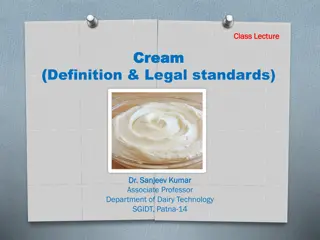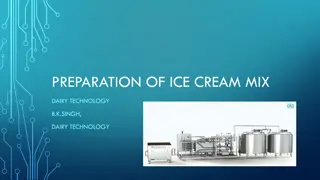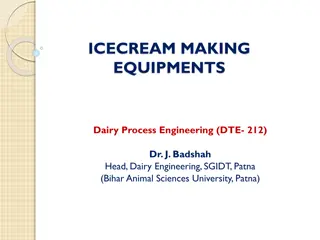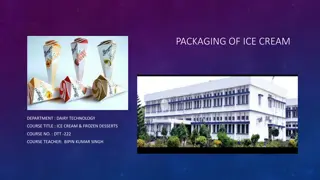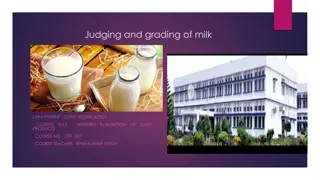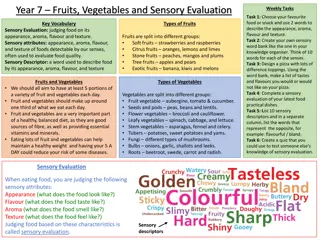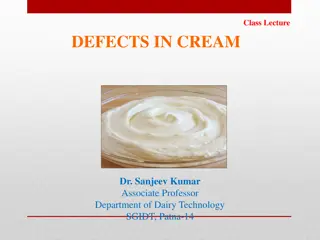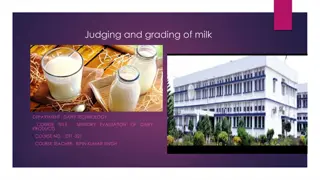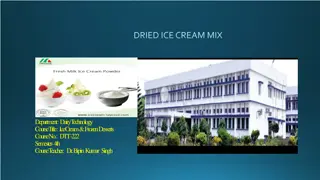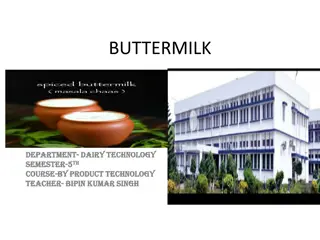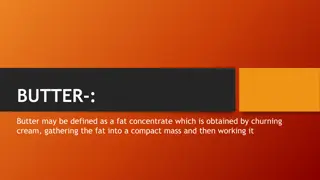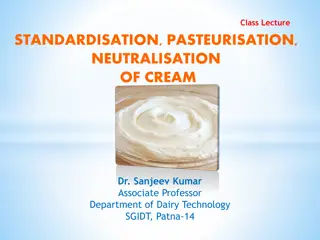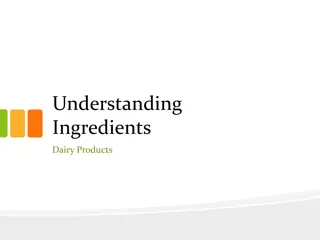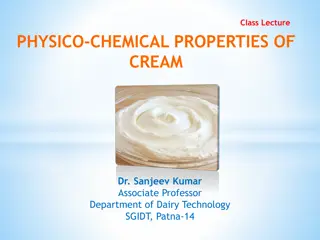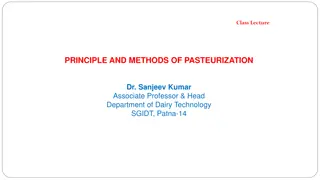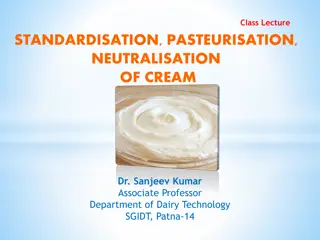Sensory Evaluation of Cream in Dairy Technology: Ice Cream & Frozen Desserts
Cream is a crucial component of dairy products, varying in fat content and processing methods. This course covers the sensory evaluation of different types of cream, including table cream, whipping cream, plastic cream, frozen cream, and more. Students learn to assess cream quality based on flavor, bacteria, sediments, temperature, container, and closure. Required materials and detailed procedures for sensory evaluation are provided, emphasizing observation, smell, appearance, taste, and consistency.
Download Presentation

Please find below an Image/Link to download the presentation.
The content on the website is provided AS IS for your information and personal use only. It may not be sold, licensed, or shared on other websites without obtaining consent from the author. Download presentation by click this link. If you encounter any issues during the download, it is possible that the publisher has removed the file from their server.
E N D
Presentation Transcript
Sensory Evaluation of Cream Department : Dairy Technology Course Title : Ice Cream & Frozen Desserts Course No. : DTT -222 Course Teacher: Bipin Kumar Singh
Introduction Cream is that portion of milk in which the fat is concentrated, usually separation It contains all the constituents of milk from which it has been separated out, but these constituents are present in different proportions. Cream differs primarily in the percentage fat, in the processing treatments, in bacteriological treatments and in the use made of them. by centrifugal
Types of Cream Table cream: (16-22% fat), Whipping cream: (30-40% fat) Plastic cream: (70-80%) fat Low fat cream: (10-12% fat) Frozen cream: Sweet cream containing50-75% fat, carefully processed and stored at 0-10 F. Devonshire cream: Obtained by handskimming shallow pans of scaled whole milk.
Contd.. Cultured sour cream: Heavy, smooth,viscous, sour cream prepared by ripening of cream by culture. Commercial sweet cream: High qualitysweet cream for use in ice cream mix and other dairy products. Churning cream: (36-42% fat). Producedprimarily for the purpose of being made into butter.
Score card for cream Score Card of Cream(ADSA) Flavour 45 Bacteria 35 Sediments 10 Temperature 5 Container and closure 5 ----------------- Total = 100
Materials Required: Cream/milk sample bottles, 100 ml beakers, plungers, sediment sediment disks, thermometer, acidity testing set, etc. tester and standard
Procedure Ascertain the condition and external appearance of the container and record observation as clean, attractive, dirty, loose lid, leaky, unsealed, dented, etc. Open the cover/lid and smell the contents immediately and examine smell and appearance of cream simultaneously. Record observation as pleasant, sour as well as any other off flavour if any, clean, foamy, fat separation, etc. Examine the inner side of the lid for adhering fat or foam. Stir the cream with plunger and note down the temperature. Perform the sediment test and compare the discs with the standard sediment discs and also estimate its Titratable acidity. Take about 50 ml of cream in a beaker from the sample and sip it. Roll it in the mouth for a few seconds and note down the flavour, mouth feel, consistency, etc. It is advised not to swallow the cream. Note down the observations in accordance to as shown in the score card and give score after deducting marks depending upon the type and intensity of defect.
Desirable attributes Ingeneral, cartooned or bottled cream should have a clean, sweet, nutty flavour, be of uniform consistency, have a good physical appearance and good keeping quality. The titratable acidity of all fresh cream should be consistent with the fat percentage of the cream. There exists and inverse relationship between the percentage of fat and the percentage of titratable acidity. Any sediment in cream is objectionable. In case of cream the bacterial limits are double those for pasteurized Grade A milk.
The order of examination, applying in large part to Table Cream in glass containers, should be as follows Serum separation Sediment Container and closure Cream plug Bacterial count Viscosity Flavour Acidity Feathering



